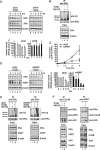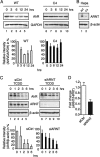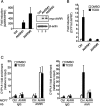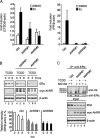A Molecular Mechanism To Switch the Aryl Hydrocarbon Receptor from a Transcription Factor to an E3 Ubiquitin Ligase
- PMID: 28416634
- PMCID: PMC5472827
- DOI: 10.1128/MCB.00630-16
A Molecular Mechanism To Switch the Aryl Hydrocarbon Receptor from a Transcription Factor to an E3 Ubiquitin Ligase
Abstract
The aryl hydrocarbon receptor (AhR) is a ligand-activated transcription factor that is known as a mediator of toxic responses. Recently, it was shown that the AhR has dual functions. Besides being a transcription factor, it also possesses an intrinsic E3 ubiquitin ligase function that targets, e.g., the steroid receptors for proteasomal degradation. The aim of this study was to identify the molecular switch that determines whether the AhR acts as a transcription factor or an E3 ubiquitin ligase. To do this, we used the breast cancer cell line MCF7, which expresses a functional estrogen receptor alpha (ERα) signaling pathway. Our data suggest that aryl hydrocarbon receptor nuclear translocator (ARNT) plays an important role in the modulation of the dual functions of the AhR. ARNT knockdown dramatically impaired the transcriptional activation properties of the ligand-activated AhR but did not affect its E3 ubiquitin ligase function. The availability of ARNT itself is modulated by another basic helix-loop-helix (bHLH)-Per-ARNT-SIM (PAS) protein, the repressor of AhR function (AhRR). MCF7 cells overexpressing the AhRR showed lower ERα protein levels, reduced responsiveness to estradiol, and reduced growth rates. Importantly, when these cells were used to produce estrogen-dependent xenograft tumors in SCID mice, we also observed lower ERα protein levels and a reduced tumor mass, implying a tumor-suppressive-like function of the AhR in MCF7 xenograft tumors.
Keywords: E3 ubiquitin ligase; aryl hydrocarbon receptor; aryl hydrocarbon receptor nuclear translocator; aryl hydrocarbon receptor repressor; molecular switch; transcription factor.
Copyright © 2017 American Society for Microbiology.
Figures






Similar articles
-
Zinc finger nuclease-mediated knockout of AHR or ARNT in human breast cancer cells abolishes basal and ligand-dependent regulation of CYP1B1 and differentially affects estrogen receptor α transactivation.Toxicol Sci. 2014 Mar;138(1):89-103. doi: 10.1093/toxsci/kft274. Epub 2013 Dec 3. Toxicol Sci. 2014. PMID: 24299737
-
Functional analysis of aryl hydrocarbon receptor nuclear translocator interactions with aryl hydrocarbon receptor in the yeast two-hybrid system.Biochem Pharmacol. 1995 Oct 12;50(8):1295-302. doi: 10.1016/0006-2952(95)02016-6. Biochem Pharmacol. 1995. PMID: 7488247
-
Distinct roles for aryl hydrocarbon receptor nuclear translocator and ah receptor in estrogen-mediated signaling in human cancer cell lines.PLoS One. 2012;7(1):e29545. doi: 10.1371/journal.pone.0029545. Epub 2012 Jan 3. PLoS One. 2012. PMID: 22235307 Free PMC article.
-
AhR acts as an E3 ubiquitin ligase to modulate steroid receptor functions.Biochem Pharmacol. 2009 Feb 15;77(4):474-84. doi: 10.1016/j.bcp.2008.08.034. Epub 2008 Sep 16. Biochem Pharmacol. 2009. PMID: 18838062 Review.
-
The complex biology of aryl hydrocarbon receptor activation in cancer and beyond.Biochem Pharmacol. 2023 Oct;216:115798. doi: 10.1016/j.bcp.2023.115798. Epub 2023 Sep 9. Biochem Pharmacol. 2023. PMID: 37696456 Free PMC article. Review.
Cited by
-
E3 Ligase Ligands in Successful PROTACs: An Overview of Syntheses and Linker Attachment Points.Front Chem. 2021 Jul 5;9:707317. doi: 10.3389/fchem.2021.707317. eCollection 2021. Front Chem. 2021. PMID: 34291038 Free PMC article. Review.
-
Exploring the Role of Ubiquitin-Proteasome System in Parkinson's Disease.Mol Neurobiol. 2022 Jul;59(7):4257-4273. doi: 10.1007/s12035-022-02851-1. Epub 2022 May 3. Mol Neurobiol. 2022. PMID: 35505049 Review.
-
Functions of the aryl hydrocarbon receptor (AHR) beyond the canonical AHR/ARNT signaling pathway.Biochem Pharmacol. 2023 Feb;208:115371. doi: 10.1016/j.bcp.2022.115371. Epub 2022 Dec 15. Biochem Pharmacol. 2023. PMID: 36528068 Free PMC article. Review.
-
Differential Modulation of Dendritic Cell Biology by Endogenous and Exogenous Aryl Hydrocarbon Receptor Ligands.Int J Mol Sci. 2023 Apr 25;24(9):7801. doi: 10.3390/ijms24097801. Int J Mol Sci. 2023. PMID: 37175508 Free PMC article.
-
AhR and Wnt/β-Catenin Signaling Pathways and Their Interplay.Curr Issues Mol Biol. 2023 May 2;45(5):3848-3876. doi: 10.3390/cimb45050248. Curr Issues Mol Biol. 2023. PMID: 37232717 Free PMC article. Review.
References
MeSH terms
Substances
LinkOut - more resources
Full Text Sources
Other Literature Sources
Medical
Miscellaneous
